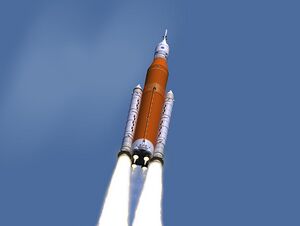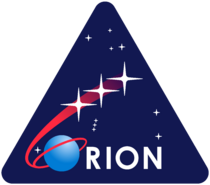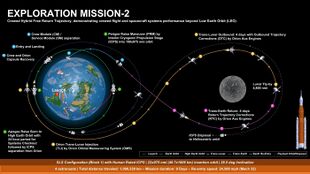Astronomy:Exploration Mission-2
 Artist's concept of the SLS Block 1A in flight. | |
| Mission type | Crewed lunar flyby |
|---|---|
| Operator | NASA |
| Spacecraft properties | |
| Spacecraft type | Orion MPCV |
| Start of mission | |
| Launch date | 2023 (planned)[1] |
| Rocket | SLS Block 1[2] |
| Launch site | Kennedy LC-39B[3] |
| End of mission | |
| Landing site | Pacific Ocean[4] |

Orion Program | |
The Exploration Mission-2, or EM-2, is a scheduled 2023 mission of the Space Launch System and possibly the first crewed mission of NASA's Orion spacecraft.[1][5]
Originally, the crewed mission was intended to collect samples from a captured asteroid in lunar orbit by the now cancelled robotic Asteroid Redirect Mission.[6] The plan is for a crewed Orion spacecraft to perform a lunar flyby test and return to Earth. As of September 2018 the last crewed spacecraft to leave low Earth orbit was Apollo 17 in 1972.
Mission objectives
Previous
Until 2017, EM-2 was a projected single-launch mission of a Space Launch System Block IB with an Exploration Upper Stage, lunar Block 1 Orion Multi-Purpose Crew Vehicle (MPCV), and a payload insertion of 50.7 t. The plan was to rendezvous with an asteroid previously placed in lunar orbit by the robotic Asteroid Redirect Mission and have astronauts perform space-walks and gather samples.[7] After the cancellation of the Asteroid Redirect Mission, it was proposed in 2017 to fly an eight-day mission with a crew of four astronauts, sent on a free return trajectory around the Moon.[8] Another proposal suggested in 2017 was to take four astronauts aboard Orion on an 8-to-21-day trip around the Moon to deliver the first element of the Lunar Orbital Platform-Gateway (LOP-G).[9]
Current
In March 2018 it was decided to launch the first Lunar Gateway module on a commercial launch vehicle[10] because of delays in building the mobile launch platform needed to hold the more powerful 'Exploration Upper Stage'.[11] (As of 2018), the EM-2 mission plan is to send four astronauts in the first crewed Orion capsule into a lunar flyby for a maximum of 21 days. The mission profile is a multi-translunar injection (MTLI), or multiple departure burns, and includes a free return trajectory from the Moon. Basically, the spacecraft will orbit Earth twice while periodically firing its engines to build up enough velocity to push it toward the Moon before looping back to Earth.[12]
Similar missions
In 1968, the Apollo 8 mission, crewed by 3 astronauts, was designed to test-fly a Command/Service Module beyond low Earth orbit. Although similar to EM-2 in that it was crewed and did not land on the Moon, it differed by entering lunar orbit for an extended stay.[13]
In 2005, the company Space Adventures announced plans to take two tourists within 100 km (62 mi) of the lunar surface using a Soyuz spacecraft piloted by a professional cosmonaut. The mission, named DSE-Alpha, has been priced at US$150 million per seat and is expected to last 8–9 days when scheduled. Company CEO Eric Anderson stated in 2011 that one seat had been sold, but the launch date has continually slipped since the second seat remains unsold (As of 2017).[14]
A SpaceX lunar tourism mission was initially proposed for late 2018 and would have been similar to EM-2 in crew size, with two space tourists paying for a free-return loop around the Moon and back to Earth, using the Crew Dragon capsule and launched on the Falcon Heavy.[15][16] After the first flight of Falcon Heavy in 2018, SpaceX announced that Falcon Heavy would not be used for crewed flights to focus their future development on BFR and indicated that the lunar mission would more likely be carried out with the BFR system.[17][18] On September 14, 2018, SpaceX officially announced that it had signed one of the paying passengers, Yusaku Maezawa, for the mission using the BFR, now rescheduled for 2023, and that he would invite 6 to 8 artists to join him.[19][20]
References
- ↑ 1.0 1.1 https://www.rocketlaunch.live/launch/em-2
- ↑ Bergin, Chris (23 February 2012). "Acronyms to Ascent – SLS managers create development milestone roadmap". http://www.nasaspaceflight.com/2012/02/acronyms-ascent-sls-managers-create-developmental-milestone-roadmap/. Retrieved 2012-07-14.
- ↑ Hill, Bill (March 2012). "Exploration Systems Development Status". NASA Advisory Council. http://www.nasa.gov/pdf/630149main_5-Hill_SLS%20MPCV%20GSDO_508.pdf. Retrieved 2012-07-21.
- ↑ Bergin, Chris (14 June 2012). "NASA teams evaluating ISS-built Exploration Platform roadmap". http://www.nasaspaceflight.com/2012/06/nasa-teams-evaluating-iss-built-exploration-platform-roadmap/. Retrieved 2012-07-21.
- ↑ Gebhardt, Chris (22 September 2017). "SLS EM-1 & -2 launch dates realign; EM-3 gains notional mission outline". https://www.nasaspaceflight.com/2017/09/sls-em-1-em-3-notional-mission-outline/. Retrieved 23 September 2017.
- ↑ Foust, Jeff (March 25, 2015). "NASA Selects Boulder Option for Asteroid Redirect Mission". Space News. http://spacenews.com/nasa-selects-boulder-option-for-asteroid-redirect-mission/. Retrieved 2015-03-27.
- ↑ Wall, Mike (April 10, 2013). "Inside NASA's Plan to Catch an Asteroid (Bruce Willis Not Required)". Space.com. TechMediaNetwork. http://www.space.com/20612-nasa-asteroid-capture-mission-explained.html. Retrieved April 10, 2013.
- ↑ Gary Daines, ed (August 4, 2017). "NASA's First Flight With Crew Will Mark Important Step on Journey to Mars". NASA. https://www.nasa.gov/feature/nasa-s-first-flight-with-crew-will-mark-important-step-on-journey-to-mars.
- ↑ Gebhardt, Chris (April 6, 2017). "NASA finally sets goals, missions for SLS – eyes multi-step plan to Mars". https://www.nasaspaceflight.com/2017/04/nasa-goals-missions-sls-eyes-multi-step-mars/.
- ↑ "NASA FY 2019 Budget Overview". https://www.nasa.gov/sites/default/files/atoms/files/nasa_fy_2019_budget_overview.pdf. Quote: "Supports launch of the Power and Propulsion Element on a commercial launch vehicle as the first component of the LOP - Gateway, (page 14)
- ↑ NASA may fly crew into deep space sooner, but there’s a price. Eric Berger. Ars Technica. 12 April 2018. Quote: "Without the Exploration Upper Stage, NASA will not be able to fly, in a single flight, crew members and pieces of a deep space gateway it hopes to build near the Moon in the 2020s."
- ↑ NASA's First Flight With Crew Will Mark Important Step on Journey to Mars. NASA - Last updated on February 9, 2018.
- ↑ Charlie Wood (25 February 2017). "Apollo 8 redux: Why NASA may send humans around the Moon, again". Christian Science Monitor. http://www.csmonitor.com/Science/Spacebound/2017/0225/Apollo-8-redux-Why-NASA-may-send-humans-around-the-moon-again.
- ↑ Moseman, Andrew (April 26, 2011). "Just One ($150 Million) Seat Remains on Space Adventures' Lunar Flyby". Popular Mechanics. http://www.popularmechanics.com/space/rockets/a13025/just-one-150-million-seat-remains-on-space-adventures-lunar-flyby/. Retrieved 2017-06-04.
- ↑ "SpaceX promises a Moon vacation in 2018". The Verge. 3 March 2017. https://www.youtube.com/watch?v=A9R3Ndv7958.
- ↑ Dave Trumbore (27 February 2017). "SpaceX Will Attempt to Send Humans Around the Moon Next Year". http://nerdist.com/spacex-will-attempt-to-send-humans-around-the-moon-next-year/.
- ↑ SpaceX no longer planning crewed missions on Falcon Heavy. Jeff Foust, Space News. February 5, 2018.
- ↑ Pasztor, Andy. "Elon Musk Says SpaceX’s New Falcon Heavy Rocket Unlikely to Carry Astronauts". Wall Street Journal. https://www.wsj.com/articles/elon-musk-says-spacexs-new-falcon-heavy-rocket-unlikely-to-carry-astronauts-1517876582?mod=rss_Technology. Retrieved 6 February 2018.
- ↑ Eric Ralph (14 September 2018). "SpaceX has signed a private passenger for the first BFR launch around the Moon". https://www.teslarati.com/spacex-private-passenger-bfr-moon-mission/. Retrieved 14 September 2018.
- ↑ Grush, Loren (14 September 2018). "SpaceX says it will send someone around the Moon on its future monster rocket". The Verge. https://www.theverge.com/2018/9/13/17857872/spacex-moon-trip-passenger-announcement-bfr. Retrieved 15 September 2018.



